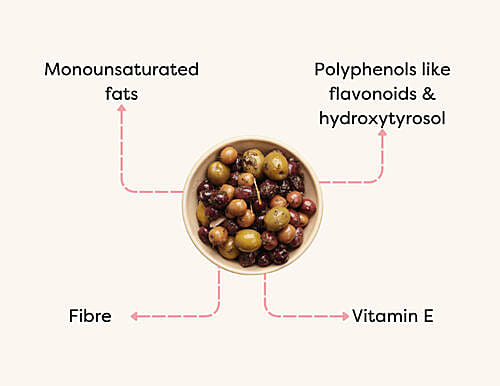Olives: Healthy or too salty?
23rd Jul 2024
Olives are a staple of the Mediterranean diet, loved for their healthy fats, fibre and polyphenols that offer anti-inflammatory and antioxidant benefits.
Key points
Health benefits
They are a source of:
- Monounsaturated fats (MUFA), particularly oleic acid, known for promoting heart health.
- Polyphenols like oleuropein, flavonoids and hydroxytyrosol, which offer powerful antioxidant and anti-inflammatory properties that could help protect from chronic diseases.
- Fibre (~3g per 100g), which adds plant diversity to your diet and supports gut health.

Similar benefits to olive oil? There aren’t many studies just on table olives, but they likely offer similar benefits. Olive oil is known for supporting heart health and possibly lowering cancer risk. Plus, table olives have the additional benefit of fibre.
What about salt?
Olives have quite a bit of salt—around 4 grams per 100 grams, which is close to the daily limit of 6 grams. But eating them in moderation is generally not a problem for most people. The discussion about sodium is ongoing, and the bigger issue tends to be with processed foods that are packed with additives and aren’t very nutritious.
How many olives should you eat a day?
Fresh olives can be a healthy part of a varied diet, adding extra nutrients and polyphenols to your plate. Just don’t overdo it—a small handful or 15-20 grams is enough to enjoy the benefits without too much salt. A quick rinse under cold water can also help wash some of it away.
How to choose ‘healthy’ olives
Processing methods can have a big impact on the content of polyphenols. Look for:
- Unflavoured – Stuffing and seasoning means further processing, which can impact quality and nutritional composition.
- With the stone – Removing the stone can lower polyphenols and health benefits.
- Greek or Spanish-style – These typically use natural fermentation and tend to contain higher amounts of polyphenols.
- Glass jars as it’s a safer non-toxic material.
Does olive colour matter? Olives change colour as they ripen, from bright green to black due to changes in pigments like chlorophylls, carotenoids and anthocyanins.
- Green olives, picked early, contain more chlorophyll and carotenoids.
- Black olives, allowed to fully mature on the tree, have higher levels of anthocyanins and monounsaturated fats.
5 ways to enjoy
- As a snack, paired with chopped vegetables like radish, celery and a red pepper dip.
- In salads with roasted vegetables, whole grains, fresh herbs and a lemon dressing.
- With pasta like Italian Puttanesca Sauce.
- In stews like slow-cooked Moroccan Tagine.
- Dips like French Tapenade, made from finely chopped olives, capers, anchovies, garlic, and olive oil.
References/sources
Table olives and health: Rocha et al. J Nutr Sci. 2020
Sodium intake & health: Gao et al. Research Methods in Medicine & Health Sciences. 2024
- Access over 800 research backed recipes
- Personalise food for your unique health needs
